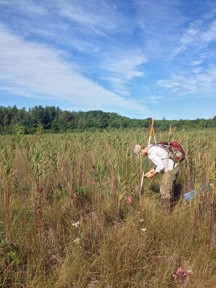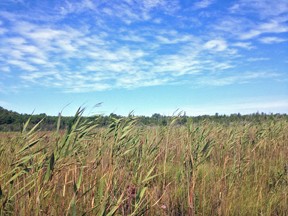Understanding Native Phragmites
- Share
- Tweet
- Pin
- Share
The phragmites that grow thick, tall and fast seem poised to take over Door County’s shoreline.
The wetland grass is enough to rally residents, naturalists and communities to learn more about the grass and work together to eradicate it – but it doesn’t tell the whole story. That threatening exotic species, likely introduced from Europe, has a native lineage that was already here.
The exotic phragmites gets all the attention, while little is known about the native grass.

Matt Peter studies native phragmites at the Mink River Estuary Nature Conservancy preserve. Photo by Carol Thompson.
“The effects of the native phragmites is a relatively understudied subject,” said Matt Peter, a graduate student at the University of Wisconsin – Green Bay. “It exists, but people don’t spend a whole lot of time or effort on it.”
That’s what Peter is out to do. He’s working with the university and The Nature Conservancy to study the differences between exotic and native phragmites.
He’s comparing stands of the exotic and native lineages of the grass in three Door County Nature Conservancy properties to see how they behave under certain conditions, like when he introduces more native seeds or rakes “leaf litter” off the soil. Then, he’ll track how the different grasses affect the soil and nearby plants.
After he’s done with the study, Peter said will take another summer out in the field plus more time analyzing the data, he’ll be able to help explain the differences between the exotic and native plants and why people should differentiate between the two when getting rid of the exotic variety.
“Just because [the native phragmites] looks similar doesn’t mean it acts the same way [as exotic phragmites],” Peter said. “Native species are important to local and regional biodiversity.”
The Door County Invasive Species Team, part of the Door County Soil and Water Conservation Department (SWCD), works to get rid of phragmites in Door County. They are starting a two-year treatment plan in Jacksonport, Egg Harbor and southern Baileys Harbor this year to eradicate the invasive grass. Southern Door was treated in the last cycle.

A view of a native phragmites stand. Photo by Carol Thompson.
As Greg Coulthurst of the SWCD said, it’s important that all the landowners in those areas are on board.
“We want to get your shoreline back and let you again manage it,” he said. “We’re not going to be able to have funding forever. The shoreline owners in the last couple years have been incredibly supporting of our effort… but there’s always one landowner on about every stretch that doesn’t participate, and that’s our Achilles heel right now.”
Peter has another fear of landowner indifference. Even if they know there’s a difference between native and exotic phragmites they might be so afraid of the exotic grass taking over they kill all the phragmites on their properties, exotic or not.
“I’m afraid that a lot of private landowners aren’t going to care,” Peter said. “Even if they know there’s a difference, they’re not going to take the time to learn the difference. I could very well be wrong about that and hopefully I am. There’s just so much fear that’s been instilled in people about the exotic, and rightfully so.
It’s quite aggressive, and I think people are just more worried that the exotic phragmites will take over.”
